Almost anytime I post a video of a Kyokushin bout there is one or more people who either make a comment about how it isn’t “realistic” because they don’t punch to the face, or, they ask the question of why they don’t. I decided to do some research and create a post that I could just share anytime those comments or questions come up.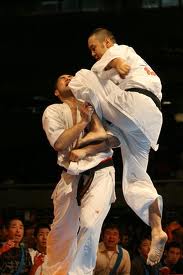
That being said, I wasn’t able to find a definitive answer, although a lot of speculation and hearsay. I would love to get a clear answer, perhaps from someone in the early days, or someone who asked Sosai Oyama directly.
From what I have gathered, in the early days of Kyokushin karate training, bare knuckle strikes to the face were allowed, but this resulted in many injuries, and blood, which caused some students to withdraw from training. Also, they wanted the matches to last, be a challenge and not end due to cuts. They did for some time wrap their hands in towels, but Sosai Oyama believed that wearing protective gloves would take away from the realistic nature that his style was building.
Therefore, it was decided that hand and elbow strikes to the face, head and neck would no longer be allowed in training and competition.
As a side, google Irish bare knuckle fighting and you will see for yourself the devastation this leaves.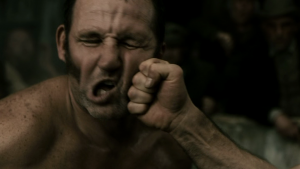
Also, when Sosai Oyama was trying to get permission from the government to host the first All-Japan tournaments he was told face-punches would not be allowed. They could use protective gloves, but as stated earlier, Sosai Oyama believed that wearing protective gloves would detract from the realism that the style emphasized. I have also read that the Japanese public feared that competitors would die at the first full-contact All-Japan tournaments held by Mas Oyama in the late 1960′s, if face punching were allowed.
Furthermore, Japan at that time, and today, along with many governments around the world, do not allow bare-knuckle strikes to the head in any sanctioned competitions.
By the 1990′s when Sosai was still alive and Kyokushin achieved such enormous popularity, all Kyokushin tournaments, including the world tournaments held in Japan, did not allow the competitors the use of hand strikes (punches, elbows, etc.) to the head and face. This was done originally for an obvious reason, as stated above. No one wanted to see so many competitors bloodied and sent to the hospital after competitions.
According to Kancho Hatsuo Royama, an early student of Sosai Mas Oyama and head of Kyokushin-kan, what differentiates the competitors of the earlier era of Kyokushin and Kyokushin competitors of the present is:
Those early students of Oyama Dojo (preceding the founding of the Kyokushinkaikan), and of early days at the Kyokushinkaikan, practiced full-contact kumite in the dojo in which punches to the head and groin (and grabbing and throwing) were all legal. This means that the Japanese fighters of the earliest Kyokushin tournaments fought with face/head punches in the dojo, and only limited their strikes to body blows at the tournaments. These fighters, therefore, knew how to defend their faces from punches. Those reflexes were well developed. According to Kancho Royama, however, a tragic development in the evolution of Kyokushin then ensued. A new, younger generation came along which aspired only to win Kyokushin tournaments in which it wasn’t necessary to develop face/head punch defensive techniques and reflexes, and the majority of all Kyokushin practitioners ceased to practice defenses against that would-be-critical aspect of what would be any real self-defense situation.
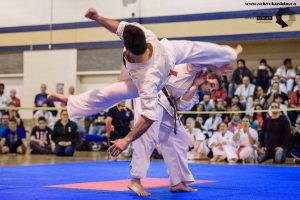
When the first Kyokushin champions were sent to fight in the K-1 kickboxing rings, following Mas Oyama’s death, they were tragically defeated, leading to a critical collapse in the popularity of Kyokushin in Japan. The Japanese public no longer believed Kyokushin to be the world’s strongest karate.
Kancho Royama points out that it is critical that we, in Kyokushin-kan, “reclaim what was lost. As karateka we must develop self-defensive reflexes against hand strikes to the head.”
Kyokushin-kan have reintroduced face striking, with tournaments for both strikes to the face, and those without. For those who wish to compete with the strikes, and those who don’t. Here is a compilation of their face striking tournaments in Japan:
I will quote Azam Ahmed, who is found on a few martial arts forums and someone I really respect in knowledge and history:
“If you read any of Sosai Oyama’s books or watch footage of the man himself – he stresses the mental aspect of martial arts more than anything else. He has on many occasions said technique/stamina are what constitutes kumite – but technique/stamina will only take you so far. Mental toughness/martial spirit is what allows you to push through your own physical limits – in my mind at least the person with the greater will & sense of purpose will prevail, if not immediately – eventually.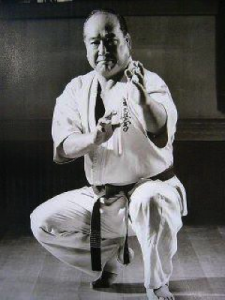
People often underrate or under-value how powerful willpower/spirit can be. It’s only when you’ve reached your limit or are in a tough place that you realise how important it can be. Pain is a great way to test & develop your will/martial spirit – knockdown karate is extremely painful when you remove (head strikes/open hand strikes to the face) because you remove the easiest way to strike/take out an opponent – it’s much harder to head kick someone – the result you get is extremely gruelling matches in knockdown karate, where will/mental toughness is usually the dividing factor – i.e. who can push through? Mental toughness is what really builds character – and you get it in regularly in training, more so in an environment where your physical limit is regularly being tested – both in kihon or kumite.
Sometimes it does come at the expense of what you realistically would expect – a punch in the face and that is one of the cons – mental toughness/conditioning being a pro. It depends though on which karateka you’re watching & his/her style – there are plenty of defensive kyokushin fighters that understand angles/movement/parrying etc etc – for some though the tactic is to slug it out with volume – you get a mix of both.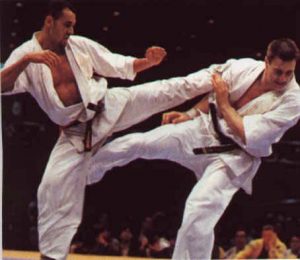
At least for me – I don’t think there is anything wrong with knockdown rules – ideally though I’d prefer Kyokushin exactly as it is now, but with MMA stand up style sparring but normal knockdown rules have their place.”
I think this sums up for me as well. Though I don’t know the original reason for no punching to the face, I do believe practically speaking why there isn’t. And further, for me at least, Kyokushin is the strongest karate, not because of its great fighting ability, which I think it has, but because it has a history and reputation of indomitable spirit. The spirit of OSU! To never give up!
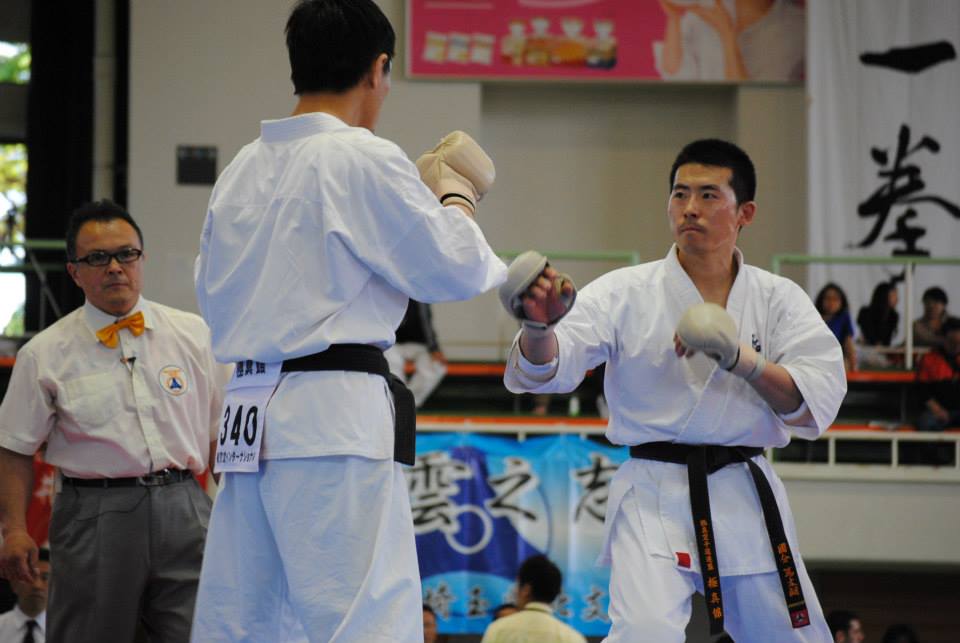
Punching to the head was never part of Kyokushin tournaments. In the early days, experimentation took place in the dojo and Oyama sent some of his fighters to compete in Thailand to fight Muay Thai. Some of Japan’s early kick boxers come from Kyokushin. The early tournaments allowed clinching and throws, were taken away for a cleaner version of pure striking. To do bare knuckle with face punching would be to change the whole dynamic of knock down karate. First of all there would be too many KOs and injuries. Secondly, there would be less activity fighters would be more… Read more »
Osu! Having been a Kyokushin Karateka for many years before turning to the way of the Nak Muay and the sport of boxing I have a couple of thoughts on your post. Head placement I crucial, and if you’re training for fighting with punches to the face you will start to position your head accordingly. That is if somebody teaches you. Otherwise you’ll just have a bunch of concussions and look for something better to do with your time than martial arts or fighting sports. Secondly, the skill of blocking, parrying, swaying, bobbing and weaving are all methods to protect… Read more »
Dear contributor, I am sorry for spelling mistakes and please accept this version: “On the other hand, sparring without hits on head was a good practice during training, especially children, and youngsters to control their fighting fever and a have them concentrate on learning the distance and even when using leg techniques, again without kicks to the head. One more idea: Originally, I started with boxing , with schoolmates only, and soon learned the price of letting somebody come too close. Karate, especially Shotokan came to my rescue, where I learned the advantage of distance saving my head., particularly as… Read more »
Dear contributor, I have spent more than 30 years in Karate and went through styles available in our country such as Shotokan, Kyokushinkai and finally Gojuryu. My humble opinion is that , learning hits to the head is a must, otherwise improper habits might develop, such as lack of attention paid to defend our head. On the other hand, spraring without hits on head was a good practice during training, especially children, and youngsters to control their fighting fever and ahave them concentrate on learning the distance andeven when using leg techniques, again without kicks to the head. With full… Read more »
Osu , very good article . I have been practicing some aspects of the full contact Martial arts available at my prime time . My personal opinion on full contact and knock out was made when I witnessed a fighter getting a severe brain damage due to blows to his head. The scary part of this was that while he was down the referee was counting and after decision of knock out he was rushed to a hospital .My view on this case was , what if this was me ,laying down there in agony and pain while a referee… Read more »
Osu! I am a Kudo Black belt and have been training in Kudo in excess of 20 years…ever since it was known as Daido Juku. The age old debate about head punches will always rage on but truth of the matter is unless you train for something you will never be a master at it. People talk about the strength of Kyokushin punches and I do agree their conditioning and strength is superhuman at the elite level, but being struck on the head and striking the head are aspects of combat you have to train every single class till it… Read more »
This was many years ago. There are gloves today and there is no logical reason why gloves and punches are not allowed today. All martial arts are fighting or simulating figthting. For Kyokushin to be effective in real life, punches need to be allowed in competition. As it is today, thousands and thousands of kyokushin blackbelts living in a sand castle, thinking that they could defend them self in real life when in reality an amateur boxer with 6 month training would make the black belt look like a annoying childs in a real fight. In fact sparring the kyokushing… Read more »
I was told by my sensei that the reason for no face punching in kyokushin was indeed for safety. The damage was immense. He said it wasn’t practical for people to have their faces smashed a few times a week because the wounds didn’t have appropriate time to heal and the cost in time off work if you needed it for broken noses, lost teeth etc, and for example, if you trained kyokushin and worked as a school teacher you couldn’t turn up for work with black eyes all the time. Gloves don’t make punches a lot softer, they just… Read more »
i have practiced itf taekwondo and have earned a second degree black belt.there face punch is allowed.face being a very vulnerable place, while sparring we generally used to avoid close proximity due to the fear of getting hit in the face. hence during the bouts, real impact was actually missing. i recently shifted to kyokushin.one of the objectives being of experiencing the real impact, which i feel should be an integral part of real martial arts. physical seasoning leads to mental seasoning, and these gets one prepared to take hits, which should be an in an integral part leading to… Read more »
I think it is less important to search for answers why Oyama had choosen this fight-rules. I’ve also heard that if he allowed punches to the face/head it will automatically means wearing gloves, … and than there is no real difference anymore between kick/Thai-boxing and Kyokushin, except the gi. He did not want this. More interesting is the discussion about how we think about it, what are the pro’s and the contra’s. Reading the notes of Azam Ahmed is very informational for me. It makes sense that if we are allowed to punch to the face/head than the knock-outs will… Read more »
Patrick Toner trained the early days of Kyokushin on the building site. He introduced Doug halloway to training there. Pat is still around in his 90s in Wellington NZ, same as Doug Halloway. Both in Wellington.
I’ve been a practisioner of Kyokushin for about a decade now. I would really like to try Kudo some time. But even though you reduce the impact energy with the head gear (and thereby the structural damage to the face), you still get the momentum shaking the brain around. I’ve read that it could even be more unsafe than without any head gear at all, because it feels safer for the receiver. I think it was from the book ”Fight Like a Physicist: The Incredible Science Behind Martial Arts”.
our dojo would only allow non contact to the head and face until you reached your yellow belt ,but we did punches and kicks to those areas but stopped the actual contact so learning control and how to defend against these techniques,without harm.
I believe the reason is according to one of Sosais books, because Sosai once got into a fight in a club and killed the opponent using his bare hands. This I believe is to be the real reason.
Osu, I have a polite observation to make. I have been a student of kyokushin since I was a kid and I am still a student even after being father of a teenager. I was a street fighting spoilt brat in my school and college days but there is one point I learned from street fighting.,Human reflex create very critical crisis whenever any strike near to eyes is noted. And that crisis is not at all predictable. In terms of whom and what. This unprectibality can ruin a base sport, as the fighters become lottery toys. The strictness on face… Read more »
I have a Black Belt on Go Khan Ryu, we always taught never to strike the face singlet level only,
however in saying so I received many bad strikes to the head from kicks which are much stronger that hand strikes.
As a human being and karateka you want to develop mentally and spiritually, not break your face and become a monster, which is really easy to achieve with punches to the head. More than this, your brain was not intended to be hit, but to think, to grow, to develop. So, full contact karate, Kyokushin, is the smartest and toughest method to grow spiritually and also physical, but not doing damage to your brain. Osu!
My teacher, Shihan Seiji Kanamura (9th dan), has told me on several occasions that in dojo sparring must include face punches, but isn’t opposed to light headgear.
He also cited aesthetics as the reason for Kyokushin dropping head punches in competition.
Perhaps mouth guards might be a solution then? It shouldn’t swing from being extremely realistic to completely avoiding face strikes.
Elbow and knee pads, as well as shin guards, could also be used if reduction of long-term harm is the intention – they wouldn’t have to be very thick or large, and can be worn under the gi.
I’ve faced kyokushinkai fighters before in sparring and the lack of protective instinct around the hand and neck is a real issue for them.
Soshu Shigeru Oyama told us in class that one time he was helping another black belt look for a tooth he had knocked out, and they found it stuck in his knuckle. They both thought this very funny, but the next day Soshu Oyama’s whole hand and arm were swollen, red, and hot, and it looked like he would lose the arm till someone managed to buy him some penicillin on the black market.
Saiko-Shihan Y. Oyama told us in class that face punching was made a foul because Sosai Oyama wanted more students.